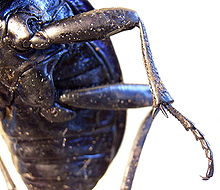Appendage
This article needs attention from an expert in Anatomy. Please add a reason or a talk parameter to this template to explain the issue with the article. (November 2013) |

In invertebrate biology, an appendage (or outgrowth) is an external body part, or natural prolongation, that protrudes from an organism's body (in vertebrate biology, an example would be a vertebrate's limbs). An appendage is any of the homologous body parts that may extend from a body segment. These include antennae, mouthparts (including mandibles, maxillae and maxillipeds), gills, walking legs (pereiopods), swimming legs (pleopods), sexual organs (gonopods), and parts of the tail (uropods). Typically, each body segment carries one pair of appendages.
An appendage which is modified to assist in feeding is known as a maxilliped or gnathopod.
Appendages may become uniramous, as in insects and centipedes, where each appendage comprises a single series of segments, or it may be biramous, as in many crustaceans, where each appendage branches into two sections. Triramous (branching into three) appendages are also possible.
All arthropod appendages are variations of the same basic structure (homologous), and which structure is produced is controlled by "homeobox" genes. Changes to these genes have allowed scientists to produce animals (chiefly Drosophila melanogaster) with modified appendages, such as legs instead of antennae.
